



Your choice of country ensures that we can offer you the right products and payment methods. Make sure that this matches the country of the account(s) on which you want to redeem the product.
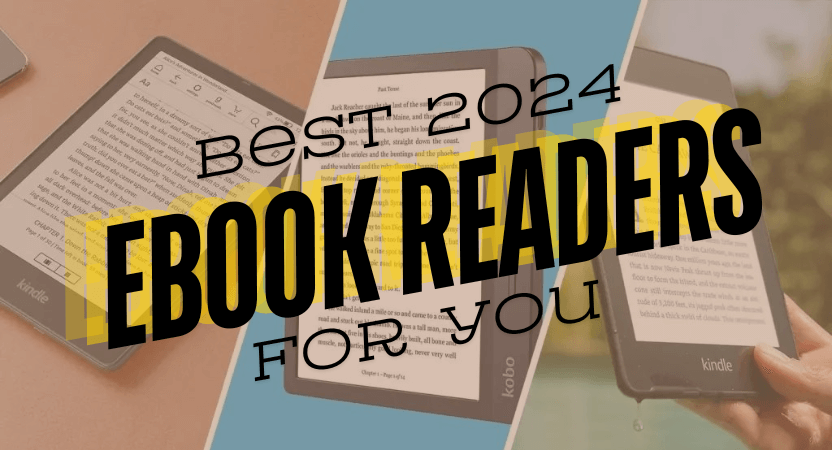
 Unlike the LCD screens commonly found in mobile phones, TV screens and monitors, ebook readers use a completely different technology called e-ink. In layman's terms, an e-ink screen is a layer of thousands of tiny black and white particles with opposite electrical charges. The device can alter the charge for each “pixel” of the screen, pushing either the white or the black particles on top, thus forming the text like a large mosaic. This technology has several advantages over LCD screens when it comes to reading:
Unlike the LCD screens commonly found in mobile phones, TV screens and monitors, ebook readers use a completely different technology called e-ink. In layman's terms, an e-ink screen is a layer of thousands of tiny black and white particles with opposite electrical charges. The device can alter the charge for each “pixel” of the screen, pushing either the white or the black particles on top, thus forming the text like a large mosaic. This technology has several advantages over LCD screens when it comes to reading:
Of course, there are also some downsides that make the e-screen good for reading and little else:
Now that you know the basics, let’s see which are the most popular devices you can buy today. This is only a selection of the most popular models, there are dozens of different or more specialized devices. The ones we present to you are all from reputable manufacturers and are perfect for the average reader. Please note that some may not be easily available in all countries. E-book readers can easily be purchased at major electronics retailers like Amazon, MediaMarkt or BOL.com with gift cards from Gamecardsdirect, the one-stop gift card shop.
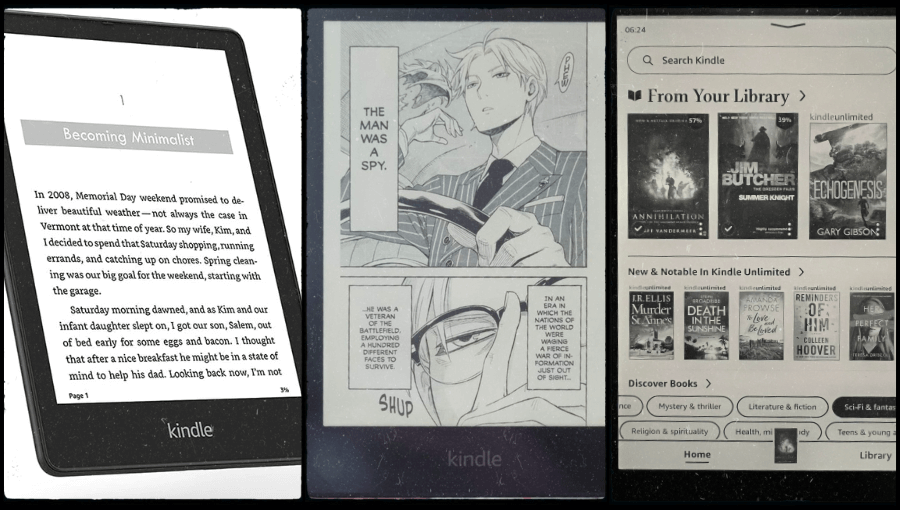
Kindle is the proprietary e-reader brand from Amazon. They have been on the market the longest and are widely reputed to be some of the best e-readers. There are several models in the lineup, with the Paperwhite being the best option balancing features, screen quality and price. It has a 6,8” display, a bit larger than models from other brands, and sports an elegant perfectly flat surface thanks to a transparent cover. This also means that there is an extra layer between your eyes and the actual screen, making the text the tiniest bit less defined. The difference is marginal, but other devices may look a little crispier.
The Paperwhite has 16GB of storage space, enough to store thousands of books (probably more than the average person can read in a lifetime), and like any Kindle can access the HUGE book collection at Amazon. It can also borrow books from public libraries using the OverDrive service, but unfortunately, this service is not widely available in Europe yet. Is it also possible to sideload your own books from different sources, but the process is not the most user-friendly. A Signature Edition of the Paperwhite also exists, costing €189.99, sporting 32GB of storage space, wireless charging and auto-adjusting front light.
In some countries, Kindle devices may come at a discounted price in exchange for ads being shown on the lock screen and the homepage. They are not as invasive as one may expect but could be annoying to some in the long run. The ads can always be removed, but it will cost 20 euros.
Bottom line: The best device to enjoy Amazon’s incredible selection of books, not the easiest for other sources.
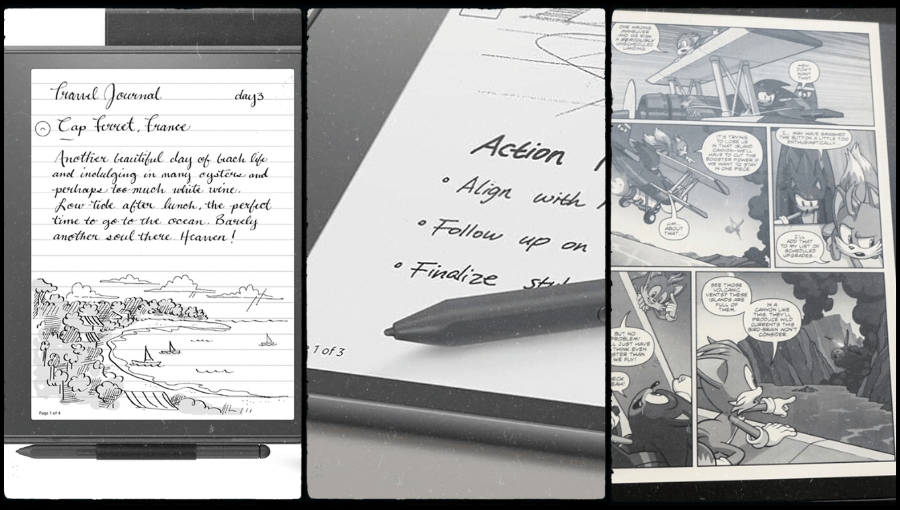
Essentially a bigger and badder Paperwhite, the Scribe has a larger 10,2” screen, 16 to 64 GB of storage space, and it works both as an ebook reader and as a digital notebook. It comes with an electronic pen that you can use to write and draw on its paper-like screen. Having a digital notebook can be a boon to people who take lots of notes, and the larger screen is obviously better suited to read any kind of content, but the size and weight can also become uncomfortable over prolonged time. With several drawing options, it can also be used to make beautiful black-and-white drawings, but we feel that a good tablet would be a better option if drawing is your main focus. Still, it’s a nice addition to an e-reader, even if it comes at a considerable price.
Bottom line: Good choice for the reader who also takes many notes and likes to occasionally draw.
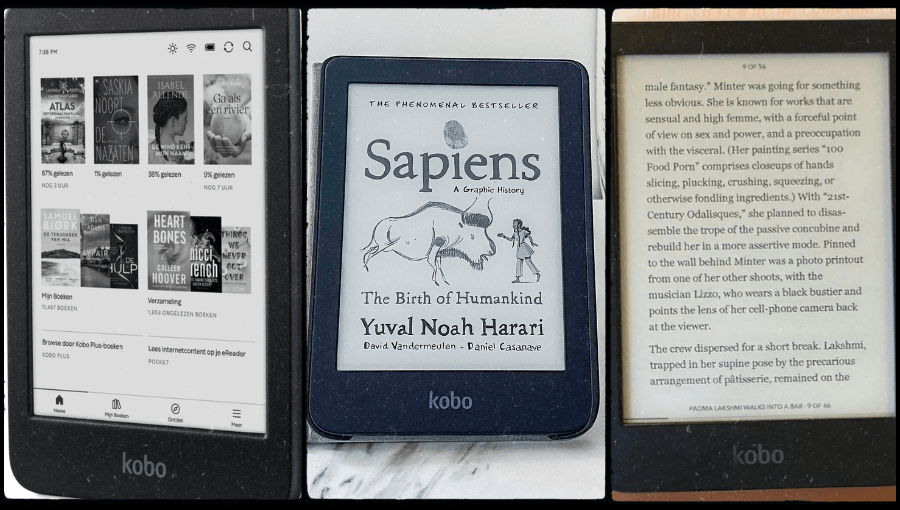
Kobo is probably the main antagonist for Kindle. They have an extensive range of excellent products and, while lacking access to the Amazon store, they more than make up for it with their own store, ease of sideloading your own content and general features. The Clara BW is the latest model in the 6” lineup and it has one of the best screens you can find today, the Carta 1300, while most other models still have the Carta 1200. The new screen is up to up to 25% faster and has 20% more contrast, providing a more pleasing experience when reading and browsing through the menus. Kobo products are more tinker-friendly than Kindle, allowing users to sideload their own content more easily and install different reading software if they want even more features. The tinker-friendliness extends to its high degree of repairability: Kobo has made its line of products easily serviceable and provided easy-to-follow instructions on the popular iFixit portal. That means that in case of a problem, any part of the products can be replaced without much trouble, and you won’t be forced to buy a whole replacement unit just because of a dead battery or a cracked screen. The outer part of the device is also made from 85% recycled plastic, helping to keep some of it out of the oceans. Way to go!
The Kobo Clara BW has 16GB of storage space and can load books in different ways, including just connecting the device to a computer through USB and dropping the files in it. It doesn’t natively have access to DropBox or other online storage services. Kobo has a reading app available for mobiles and computers, so you can sync your reading across all your devices. This will only work for content purchased through the proprietary Rakuten Store, though, you won’t be able to sync books from other sources.
Bottom line: Excellent and inexpensive environmentally friendly device that will be a faithful reading companion for many years to come.
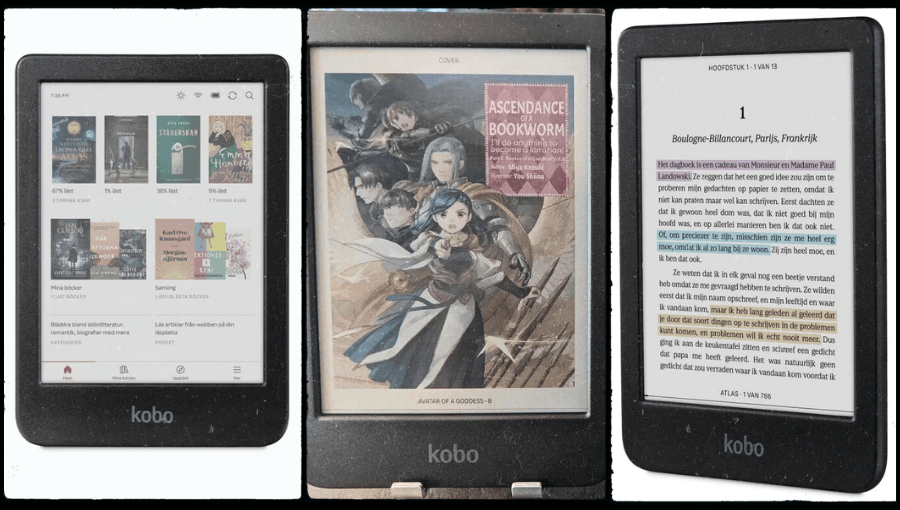
The Clara Colour is basically the same as the Clara BW except for a major difference: it has a colour screen! This one would seem the obvious choice, also considering the small price difference between the two models, but the addition of colour brings its own set of downsides. First of all, the colours are quite muted and have a watercolour quality, the device’s capabilities are far from the bright, vivid screen of a tablet. Secondly, the colour is achieved by adding a second, lower-resolution screen on top of the black and white one. This means that even when reading B/W content the crispiness of the display will be a little lower, due to the extra layer in front of it, and a thin grid like a mesh pattern is visible at all times. Most importantly, the extra screen will make the image darker, with less contrast. You will need to put the frontlight at 30% setting to have a similar visual experience as the BW screen with 0-5% light, resulting in a shorter battery life.
Being able to finally see book covers and illustrations in colour is certainly nice, not to mention highlighting text with different hues when taking notes, but we feel the technology is not yet mature enough to make it worth it: if you mostly read black and white, the colour layer will make your reading a little pleasant. If your main goal is colour content (comics, for example) you will be much better off with a tablet, for the time being. The best thing to do, if possible, would be to check the screen yourself at a large retailer and decide for yourself if the pros outweigh the cons.
Bottom line: Interesting device but not mature enough technology yet, good for people who want the latest features regardless.
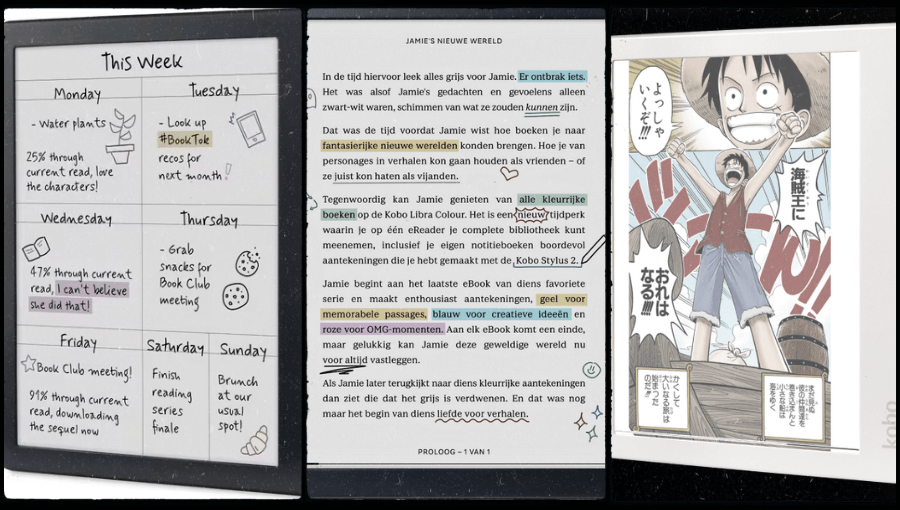
The Libra, only coming in the Colour version (no black-and-white only model available), is like a Clara Colour with an expanded set of features. The first obvious difference is its appearance: it has a larger 7” screen and a wider frame with 2 prominent buttons. Less visible but equally important is the fact that this device has 32GB of storage space and supports syncing books through DropBox and Google Drive. You can also purchase a proprietary pen for it, the Kobo Stylus 2 (sold separately), that will allow you to write on the screen as on paper. And this leads us to the real purpose of this device: its focus is less on a pure reading experience and more on a note-taking, organizing device. On the Libra Colour you can underline, highlight and scribble on the book pages, as well as organize your agenda, take notes, draw sketches and more. Every consideration about the colour screen of its smaller sister, the Clara Colour, is valid for the Libra too, but it has much less weight due to the different focus of the device. You won’t buy a Libra if your plan is only pure, unadulterated reading but its note-taking capabilities make it a much more versatile device that could be perfect for manuals and school textbooks, for example.
Bottom line: Great device to be used as agenda, notebook and e-reader, the colour screen adds a lot of meaning here.
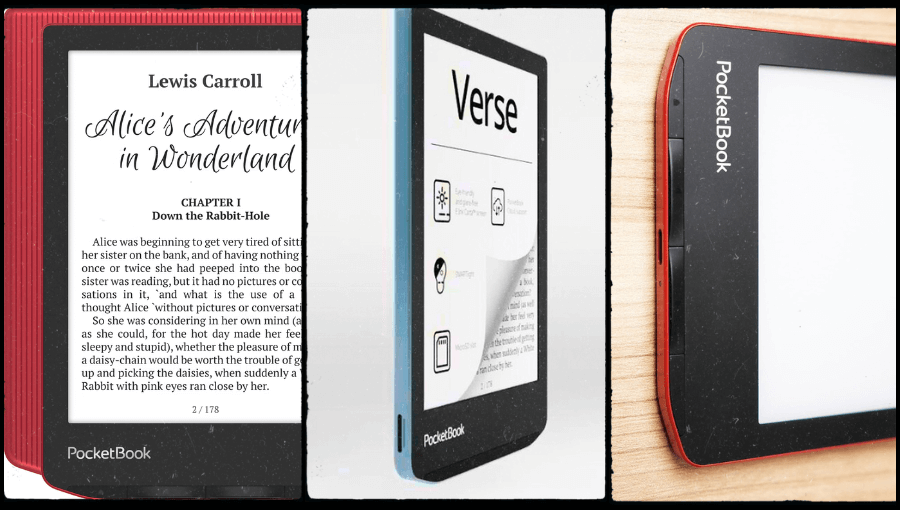
Last manufacturer in our lineup is Pocketbook, with the newly-released Verse Pro. This device has a 6” Carta 1200 screen, 16GB of storage space, and has a premium build quality with a rugged back, either in blue or red. It is by far the most eye-pleasing device of our little lineup, and as per PocketBook philosophy it’s all about user customization and freedom of choice. While Kindle is fairly closed in its own you-get-what-you-get system, and Kobo leaves some options open without straying too much from the path, with the Verse Pro you will get a ton of personalization options to make any aspect of your reading exactly as you want it. You can even set a daily program for the front light, fine-setting its colour and intensity according to the time of day!
Another prominent feature of this device: it has buttons! Where most of the alternatives got rid of physical buttons, relying on the touchscreen for everything, this reader has 4 nice, well-built, highly configurable buttons to turn the page, adjust the light or any other possible action. You can do everything on the touchscreen, of course, but isn’t it nice to have quick shortcuts for the most common actions? You will also find a handful of apps besides the reader, that make sensible use of the always-on, energyless screen, like a calendar and an app that turns the device into a photo frame.
PocketBook has its own bookstore, but it has nowhere as many titles as Amazon or Rakuten. It makes up for it by allowing users to easily load content from any source, which is great news for anyone who likes to buy their reads in different places or already owns a lot of content. Another good thing is that you can sync all your reading across different devices, not being limited to the ones bought through the store.
Bottom line: It does its job without interfering in any way, allowing users to set their reading experience however they like. Did we say it has buttons?
Your choice of country ensures that we can offer you the right products and payment methods. Make sure that this matches the country of the account(s) on which you want to redeem the product.